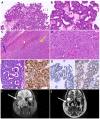A Pediatric Case of High-Grade Secretory Carcinoma of the Maxillary Sinus With ETV6::NTRK3 Gene Fusion, Therapeutic Implications, and Review of the Literature
- PMID: 36448441
- PMCID: PMC9909029
- DOI: 10.1177/10935266221138706
A Pediatric Case of High-Grade Secretory Carcinoma of the Maxillary Sinus With ETV6::NTRK3 Gene Fusion, Therapeutic Implications, and Review of the Literature
Abstract
Secretory carcinoma (SC) is a salivary gland tumor with a generally low grade microscopic appearance, a characteristic immunophenotype, and a recurrent translocation leading to ETV6::NTRK3 fusion gene. Rare cases are reported in children. The maxillary sinus is an unusual localization. SC have an overall favorable prognosis, but cases with high grade morphology have been described in adult population and are related to a more aggressive clinical course. We present a pediatric case of secretory carcinoma involving the maxillary sinus with high grade morphology, with a review of the literature of secretory carcinomas with high grade component.
Keywords: pediatric secretory carcinoma high grade.
Conflict of interest statement
The author(s) declared no potential conflicts of interest with respect to the research, authorship, and/or publication of this article.
Figures

References
-
- El-Naggar AK, Chan JKC, Grandis JR, Takata T, Slootweg PJ. WHO Classification of Head and Neck Tumours. 4th ed. IARC; 2017.
-
- Alves LDB, de Melo AC, Farinha TA, et al.. A systematic review of secretory carcinoma of the salivary gland: where are we? Oral Surg Oral Med Oral Pathol Oral Radiol. 2021;132:e143-e152. - PubMed
-
- Ngouajio AL, Drejet SM, Phillips DR, Summerlin DJ, Dahl JP. A systematic review including an additional pediatric case report: pediatric cases of mammary analogue secretory carcinoma. Int J Pediatr Otorhinolaryngol. 2017;100:187-193. - PubMed
-
- Quattlebaum SC, Roby B, Dishop MK, Said MS, Chan K. A pediatric case of mammary analogue secretory carcinoma within the parotid. Am J Otolaryngol. 2015;36:741-743. - PubMed
-
- Hwang MJ, Wu PR, Chen CM, Chen CY, Chen CJ. A rare malignancy of the parotid gland in a 13-year-old Taiwanese boy: case report of a mammary analogue secretory carcinoma of the salivary gland with molecular study. Med Mol Morphol. 2014;47:57-61. - PubMed
Publication types
MeSH terms
Substances
Supplementary concepts
LinkOut - more resources
Full Text Sources

